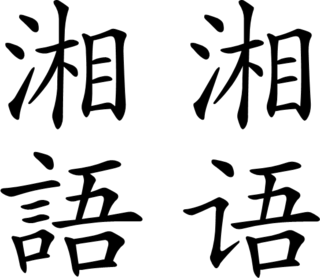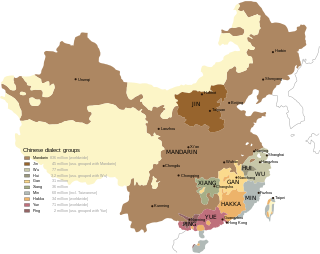
Mandarin is a group of Sinitic dialects that are natively spoken across most of northern and southwestern China. The group includes the Beijing dialect, the basis of the phonology of Standard Chinese, the official language of China. Because Mandarin originated in North China and most Mandarin dialects are found in the north, the group is sometimes referred to as Northern Chinese. Many varieties of Mandarin, such as those of the Southwest and the Lower Yangtze, are not mutually intelligible with the standard language. Nevertheless, Mandarin as a group is often placed first in lists of languages by number of native speakers.

Standard Chinese is a modern standardized form of Mandarin Chinese that was first codified during the Republican Era (1912‒1949). It is designated as the official language of mainland China and a major language in the United Nations, Singapore, and Taiwan. It is largely based on the Beijing dialect. Standard Chinese is a pluricentric language with local standards in mainland China, Taiwan and Singapore that mainly differ in their lexicon. Hong Kong written Chinese, used for formal written communication in Hong Kong and Macau, is a form of Standard Chinese that is read aloud with the Cantonese reading of characters.

Middle Chinese or the Qieyun system (QYS) is the historical variety of Chinese recorded in the Qieyun, a rime dictionary first published in 601 and followed by several revised and expanded editions. The Swedish linguist Bernard Karlgren believed that the dictionary recorded a speech standard of the capital Chang'an of the Sui and Tang dynasties. However, based on the preface of the Qieyun, most scholars now believe that it records a compromise between northern and southern reading and poetic traditions from the late Northern and Southern dynasties period. This composite system contains important information for the reconstruction of the preceding system of Old Chinese phonology.

Jin is a proposed group of varieties of Chinese spoken by roughly 63 million people in northern China, including most of Shanxi province, much of central Inner Mongolia, and adjoining areas in Hebei, Henan, and Shaanxi provinces. The status of Jin is disputed among linguists; some prefer to include it within Mandarin, but others set it apart as a closely related, but separate sister-group.
Teochew or Chaozhou is a dialect of Chaoshan Min, a Southern Min language, that is spoken by the Teochew people in the Chaoshan region of eastern Guangdong and by their diaspora around the world. It is sometimes referred to as Chiuchow, its Cantonese rendering, due to English romanization by colonial officials and explorers. It is closely related to some dialects of Hokkien, as it shares some cognates and phonology with Hokkien. The two are mutually unintelligible, but it is possible to understand some words.

Xiang or Hsiang, also known as Hunanese, is a group of linguistically similar and historically related Sinitic languages, spoken mainly in Hunan province but also in northern Guangxi and parts of neighboring Guizhou, Guangdong, Sichuan, Jiangxi and Hubei provinces. Scholars divided Xiang into five subgroups, Chang-Yi, Lou-Shao, Hengzhou, Chen-Xu and Yong-Quan. Among those, Lou-shao, also known as Old Xiang, still exhibits the three-way distinction of Middle Chinese obstruents, preserving the voiced stops, fricatives, and affricates. Xiang has also been heavily influenced by Mandarin, which adjoins three of the four sides of the Xiang speaking territory, and Gan in Jiangxi Province, from where a large population immigrated to Hunan during the Ming dynasty.

The Sinitic languages, often synonymous with the Chinese languages, are a group of East Asian analytic languages that constitute a major branch of the Sino-Tibetan language family. It is frequently proposed that there is a primary split between the Sinitic languages and the rest of the family. This view is rejected by a number of researchers but has found phylogenetic support among others. The Greater Bai languages, whose classification is difficult, may be an offshoot of Old Chinese and thus Sinitic; otherwise Sinitic is defined only by the many varieties of Chinese unified by a shared historical background, and usage of the term "Sinitic" may reflect the linguistic view that Chinese constitutes a family of distinct languages, rather than variants of a single language.

Sichuanese or Szechwanese (simplified Chinese: 四川话; traditional Chinese: 四川話; Sichuanese Pinyin: Si4cuan1hua4; pinyin: Sìchuānhuà; Wade–Giles: Szŭ4-ch'uan1-hua4), also called Sichuanese/Szechwanese Mandarin (simplified Chinese: 四川官话; traditional Chinese: 四川官話; pinyin: Sìchuān Guānhuà), is a branch of Southwestern Mandarin spoken mainly in Sichuan and Chongqing, which was part of Sichuan Province until 1997, and the adjacent regions of their neighboring provinces, such as Hubei, Guizhou, Yunnan, Hunan and Shaanxi. Although "Sichuanese" is often synonymous with the Chengdu-Chongqing dialect, there is still a great amount of diversity among the Sichuanese dialects, some of which are mutually unintelligible with each other. In addition, because Sichuanese is the lingua franca in Sichuan, Chongqing and part of Tibet, it is also used by many Tibetan, Yi, Qiang and other ethnic minority groups as a second language.

Southwestern Mandarin, also known as Upper Yangtze Mandarin, is a Mandarin Chinese dialect spoken in much of Southwest China, including in Sichuan, Yunnan, Chongqing, Guizhou, most parts of Hubei, the northwestern part of Hunan, the northern part of Guangxi and some southern parts of Shaanxi and Gansu.
The Changsha dialect is a dialect of New Xiang Chinese. It is spoken predominantly in Changsha, the capital of Hunan province, China. It is not mutually intelligible with Standard Mandarin, the official language of China.

Leizhou or LuichewMin is a branch of Min Chinese spoken in Leizhou city, Xuwen County, Mazhang District, most parts of Suixi County and also spoken inside of the linguistically diverse Xiashan District. In the classification of Yuan Jiahua, it was included in the Southern Min group, though it has low intelligibility with other Southern Min varieties. In the classification of Li Rong, used by the Language Atlas of China, it was treated as a separate Min subgroup. Hou Jingyi combined it with Hainanese in a Qiong–Lei group.
This article summarizes the phonology of Standard Chinese.
Differing literary and colloquial readings for certain Chinese characters are a common feature of many Chinese varieties, and the reading distinctions for these linguistic doublets often typify a dialect group. Literary readings are usually used in loanwords, names, literary works, and in formal settings, while colloquial/vernacular readings are usually used in everyday vernacular speech.

The Minjiang dialect is a branch of Sichuanese, spoken mainly in the Min River (Mínjiāng) valley or along the Yangtze in the southern and western parts of the Sichuan Basin in China. There is also a language island of the Minjiang dialect located in the center of the Sichuan Basin covering several counties, including all of Xichong, Yanting, and Shehong Counties, and part of Jiange, Cangxi, Nanbu, Langzhong and Bazhong. The Minjiang dialect is also referred to as the Nanlu dialect by some scholars.
Old Mandarin or Early Mandarin was the speech of northern China during the Jurchen-ruled Jin dynasty and the Mongol-led Yuan dynasty. New genres of vernacular literature were based on this language, including verse, drama and story forms, such as the qu and sanqu.

Northern Min is a group of mutually intelligible Min varieties spoken in Nanping prefecture of northwestern Fujian.
The Nanjing dialect, also known as Nankingese, Nanjingese and Nanjing Mandarin, is the prestige dialect of Mandarin spoken in the urban area of Nanjing, China. It is part of the Jianghuai group of Chinese varieties.

Chengdu-Chongqing dialect or Cheng–Yu is the most widely used branch of Southwestern Mandarin, with about 90 million speakers. It is named after Chengdu, the capital city of Sichuan, and Chongqing, which was split from Sichuan in 1997. It is spoken mainly in northern and eastern Sichuan, the northeastern part of the Chengdu Plain, several cities or counties in southwestern Sichuan, southern Shaanxi and western Hubei.

Mandarin was the common spoken language of administration of the Chinese empire during the Ming and Qing dynasties. It arose as a practical measure, due to the mutual unintelligibility of the varieties of Chinese spoken in different parts of China. Knowledge of this language was thus essential for an official career, but it was never formally defined. The language was a koiné based on Mandarin dialects. The southern variant spoken around Nanjing was prevalent in the late Ming and early Qing eras, but a form based on the Beijing dialect became dominant by the mid-19th century and developed into Standard Chinese in the 20th century. In some 19th-century works, it was called the court dialect.
In Chinese dialectology, Beijing Mandarin refers to a major branch of Mandarin Chinese recognized by the Language Atlas of China, encompassing a number of dialects spoken in areas of Beijing, Hebei, Inner Mongolia, Liaoning, and Tianjin, the most important of which is the Beijing dialect, which provides the phonological basis for Standard Chinese. Both Beijing Mandarin and its Beijing dialect are also called Beijingese.












